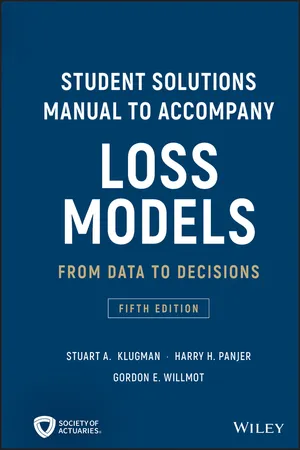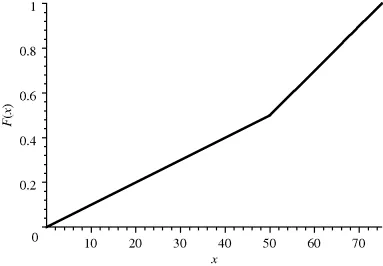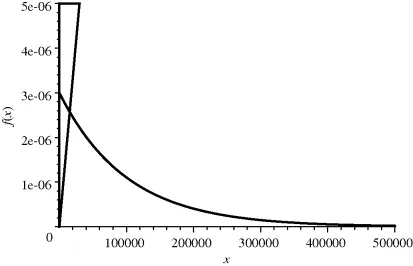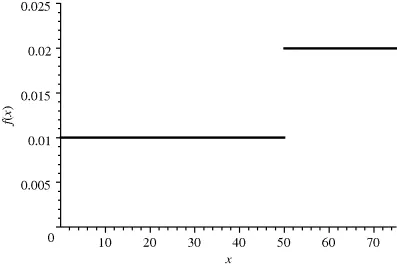
eBook - ePub
Loss Models: From Data to Decisions, 5e Student Solutions Manual
- English
- ePUB (mobile friendly)
- Available on iOS & Android
eBook - ePub
Loss Models: From Data to Decisions, 5e Student Solutions Manual
About this book
Solutions manual to accompany a text with comprehensive coverage of actuarial modeling techniques The Student Solutions Manual to Accompany Loss Models: From Data to Decisions covers solutions related to the companion text. The manual and text are designed for use by actuaries and those studying for the profession. Readers can learn modeling techniques used across actuarial science. Knowledge of the techniques is also beneficial for those who use loss data to build models for risk assessment.
Frequently asked questions
Yes, you can cancel anytime from the Subscription tab in your account settings on the Perlego website. Your subscription will stay active until the end of your current billing period. Learn how to cancel your subscription.
No, books cannot be downloaded as external files, such as PDFs, for use outside of Perlego. However, you can download books within the Perlego app for offline reading on mobile or tablet. Learn more here.
Perlego offers two plans: Essential and Complete
- Essential is ideal for learners and professionals who enjoy exploring a wide range of subjects. Access the Essential Library with 800,000+ trusted titles and best-sellers across business, personal growth, and the humanities. Includes unlimited reading time and Standard Read Aloud voice.
- Complete: Perfect for advanced learners and researchers needing full, unrestricted access. Unlock 1.4M+ books across hundreds of subjects, including academic and specialized titles. The Complete Plan also includes advanced features like Premium Read Aloud and Research Assistant.
We are an online textbook subscription service, where you can get access to an entire online library for less than the price of a single book per month. With over 1 million books across 1000+ topics, we’ve got you covered! Learn more here.
Look out for the read-aloud symbol on your next book to see if you can listen to it. The read-aloud tool reads text aloud for you, highlighting the text as it is being read. You can pause it, speed it up and slow it down. Learn more here.
Yes! You can use the Perlego app on both iOS or Android devices to read anytime, anywhere — even offline. Perfect for commutes or when you’re on the go.
Please note we cannot support devices running on iOS 13 and Android 7 or earlier. Learn more about using the app.
Please note we cannot support devices running on iOS 13 and Android 7 or earlier. Learn more about using the app.
Yes, you can access Loss Models: From Data to Decisions, 5e Student Solutions Manual by Stuart A. Klugman,Harry H. Panjer,Gordon E. Willmot in PDF and/or ePUB format, as well as other popular books in Volkswirtschaftslehre & Finanzwesen. We have over one million books available in our catalogue for you to explore.
Information
Chapter 1
Introduction
The solutions presented in this manual reflect the authors' best attempt to provide insights and answers. While we have done our best to be complete and accurate, errors may occur and there may be more elegant solutions. Errata will be linked from the syllabus document for any Society of Actuaries examination that uses this text.
Should you find errors, or if you would like to provide improved solutions, please send your comments to Stuart Klugman at [email protected].
Chapter 2
Solutions
Section 2.2
- 2.1



- 2.2 The requested plots follow. The triangular spike at zero in the density function for Model 4 indicates the 0.7 of discrete probability at zero.
- 2.3 . Setting the derivative equal to zero and multiplying by
 gives the equation
gives the equation . This is equivalent to
. This is equivalent to . The only positive solution is the mode of
. The only positive solution is the mode of .
.
 Figure 2.1 The distribution function for Model 3.
Figure 2.1 The distribution function for Model 3. Figure 2.2 The distribution function for Model 4.
Figure 2.2 The distribution function for Model 4. Figure 2.3 The distribution function for Model 5.
Figure 2.3 The distribution function for Model 5. Figure 2.4 The probability function for Model 3.
Figure 2.4 The probability function for Model 3. Figure 2.5 The density function for Model 4.
Figure 2.5 The density function for Model 4. Figu...
Figu...
Table of contents
- Cover
- Series Page
- Title Page
- Copyright
- Chapter 1: Introduction
- Chapter 2: Solutions
- Chapter 3: Solutions
- Chapter 4: Solutions
- Chapter 5: Solutions
- Chapter 6: Solutions
- Chapter 7: Solutions
- Chapter 8: Solutions
- Chapter 9: Solutions
- Chapter 10: Solutions
- Chapter 11: Solutions
- Chapter 12: Solutions
- Chapter 13: Solutions
- Chapter 14: Solutions
- Chapter 15: Solutions
- Chapter 16: Solutions
- Chapter 17: Solutions
- Chapter 18: Solutions
- Chapter 19: Solutions
- End User License Agreement